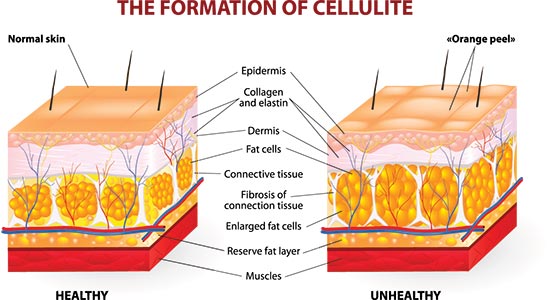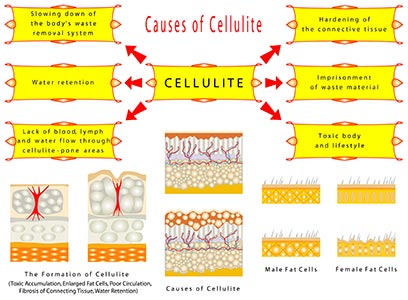What is cellulite?
Cellulite is the accumulation of fat layers under the skin that give it a dimpled appearance. In simple words, cellulite is the orange peel like skin you see when you put on too much weight. The skin is connected by fibrous vertical bands made of tissue. When the fat cells in the top layers of the skin start to swell, the skin bulges out and the bands are pressed downwards. This up and down movement gives skin the wrinkly texture. Cellulite is commonly found in the thigh, buttocks, legs, stomach and arms but not restricted to these areas.
What Causes Cellulite?
The biggest irony is that you can be lean and fit and still have cellulite. Hence, cellulite isn't just restricted to obese or those with a lot of body fat. Various factors can contribute to cellulite build up in your body and following are a few of them:
Sedentary lifestyle:
This is the biggest contributor of cellulite in the body. Little or no physical activity, unhealthy eating habits and stress can make you overweight and increase the amount of cellulite too.
Body weight:
Cellulite is more common in females due to the presence of oestrogen. High levels of the hormone oestrogen can cause cellulite. Overweight people produce more oestrogen than other individuals and hence cellulite appears.
Oral contraceptives:
Taking oral contraceptives increases the levels of oestrogen in your body. Since oestrogen destroys the connective tissue found in the skin layers, cellulite occurs. Oral contraceptives may also cause water retention in the body which aggravates the appearance of cellulite.
Genetics and age:
If it runs in the family, you're likely to develop cellulite too. Also, as you age, the fibrous tissues lose elasticity and cellulite becomes more visible.
Pregnancy or menopause:
Hormonal changes can affect the body in many ways and can be linked to weight gain too. The sudden spike or decrease in the level of oestrogen during menopause and pregnancy can affect the connective tissue in the skin and increase cellulite formation. Fluid retention in the body during pregnancy can also lead to cellulite build up. It's also more visible post menopause as the skin becomes thinner.
Other factors:
Wearing tight clothing can also give rise to cellulite as it traps the toxins in the body by restricting proper blood flow. According to studies, excessive intake of caffeine can also cause cellulite by affecting the blood circulation in the skin.
Types Of Cellulite
Knowing the type of cellulite you have makes dealing with it easier. There are different ways to handle cellulite and in fact the grade of cellulite also matters while deciding the plan of action to get rid of it.
Adipose cellulite:
Sedentary lifestyle and bad eating habits cause this type of cellulite which is visible when you pinch the skin. It's simpler to get rid of this kind by tweaking your everyday habits and diet and using a few anti-cellulite products such as creams, gels, patches and devices.
Aqueous cellulite:
As the name suggests, this one is caused by water retention and also poor blood circulation. The skin looks wrinkly like an orange peel and is harder than with adipose cellulite or just fat accumulation. Most women suffer from this type of cellulite which can be reduced by controlling salt intake and drinking lots of water.
Fibrous cellulite:
This is the most tenacious type of cellulite and the most common symptom is hardened skin and a purplish hue. It's caused by cellulite that's left untreated and converts into hardened deposits over time that can be painful in most cases. Boosting the metabolism with supplements, regular exercise, regular massaging, anti-cellulite creams and modifications in the diet can help minimise the effect of this type of cellulite.
How Much Cellulite Do You Have?
Cellulite is extremely common and almost everyone may have it at some point in their lives. But how much of it do you actually have and how early can you get rid of it? For this purpose, cellulite can be graded based on its appearance and not just types. Take a look to identify your stage:
Stage 1: Cellulite isn’t visible at all when you stand or lay, or when you pinch the skin around thighs or stomach. Cellulite may still be present but in very small amounts.
Stage 2: In this grade, cellulite is visible when pinched but not when you stand or lay.
Stage 3: The cellulite, in this case, is visible when you stand due to the creasing or tightening of skin. However, no cellulite is visible when you lay or sit.
Stage 4: This grade resembles fibrous cellulite and hence it's clearly visible in all positions. It's stubborn cellulite and takes a lot of time to disappear.
Natural Solutions To Get Rid Of Cellulite
Cellulite may not just have a negative impact on your physical appearance; it can also sap the confidence of many women who feel embarrassed to flaunt their favourite bikini or that little black dress. It can also affect their self-esteem in the bedroom too. Cellulite isn’t an incurable condition. But it takes time to reduce and requires diligently following a regimen to treat the condition. Here are a few realistic ways that can help you get rid of cellulite:
- Eat healthy and watch your sodium intake. Eating too much salt can lead to swelling of fat cells making cellulite more visible. Fresh fruits, vegetables and high fibre foods help flush out toxins and keep your weight in check, thus making it easier to get rid of cellulite.
- Exercise and physical activity can help scare the cellulite off. Exercise improves blood circulation and hence curbs formation of more cellulite. It also regulates the hormones and thus prevents accumulation of fat and cellulite.
- Applying anti-cellulite creams and oils post workout or exercise helps boost your efforts to smooth the skin out. Look for collagen boosting creams and lotions with natural ingredients which are becoming increasingly popular.
- Massaging the cellulite affected areas boosts blood circulation and helps break down the fat cells that cause cellulite. Using anti-cellulite creams and oils for massage gives an added advantage as these creams are made with natural ingredients that have the potential to help you get rid of cellulite.
- Anti-cellulite supplements are also available in the market that can boost collagen in the skin and may also help drain excess fluids to reduce the effects of cellulite.
- Body contouring devices that can be used at home are also easily available. These help tighten the loose skin layers and also help get rid of cellulite by directly targeting the fat cells to reduce the bumpy effect.
The Final Word
Treating the early signs of cellulite is the best way to get rid of it. Since cellulite is present in different grades in different people, the time taken for it to disappear or fade is also different. Even if your cellulite is genetic, you can reduce it or get rid of it by tweaking your lifestyle, dietary changes and adding a few natural anti-cellulite products to aid your efforts.




